Removal of Natural Organic Matter and Organic Micropollutants during Riverbank Filtration in Krajkowo, Poland
Abstract
:1. Introduction
2. Materials and Methods
2.1. Site Description
- a gallery of 29 vertical wells (RBF-c) on the left side of the Warta River located at a distance of 60–80 m from the river channel (Figure 3),
- a horizontal well (HW) with drains placed 5 m below the river bottom (Figure 3). The drains were installed by excavation (dredging) of the riverbed sediments.
2.2. Methods
3. Results
4. Discussion
5. Conclusions
Author Contributions
Funding
Acknowledgments
Conflicts of Interest
References
- Hiscock, K.M.; Grischek, T. Attenuation of groundwater pollution by bank filtration. J. Hydrol. 2002, 266, 139–144. [Google Scholar] [CrossRef] [Green Version]
- Foriczs, T.; Berecz, Z.; Molnar, Z.; Suveges, M. Origin of shallow groundwater of Csepel Island (south of Budapest. Hungary. River Danube): Isotopic and chemical approach. Hydrol. Process. 2005, 19, 3299–3312. [Google Scholar] [CrossRef]
- Lasagna, M.; De Luca, D.A.; Franchino, E. Nitrates contamination of groundwater in the western Po Plain (Italy): The effects of groundwater and surface water interactions. Environ. Earth Sci. 2016, 75, 240. [Google Scholar] [CrossRef]
- Grunheid, S.; Amy, G.; Jekel, M. Removal of bulk dissolved organic carbon (DOC) and trace organic compounds by bank filtration and artificial recharge. Water Res. 2005, 39, 3219–3228. [Google Scholar] [CrossRef] [PubMed]
- Hoppe-Jones, C.; Oldham, G.; Drewes, J.E. Attenuation of total organic carbon and unregulated trace organic chemicals in U.S. riverbank filtration systems. Water Res. 2010, 44, 4643–4659. [Google Scholar] [CrossRef] [PubMed]
- Górski, J.; Dragon, K.; Kruć, R. A comparison of river water treatment efficiency in different types of wells. Geologos 2018, in press. [Google Scholar] [CrossRef]
- Miettinen, I.T.; Martikainen, P.J.; Vartiainen, T. Humus transformation at the bank filtration water plant. Water Sci. Techol. 1994, 30, 179–187. [Google Scholar] [CrossRef]
- Ray, C.; Soong, T.W.; Lian, Y.Q.; Roadcap, G.S. Effect of flood-induced chemical load on filtrate quality at bank filtration sites. J. Hydrol. 2002, 266, 235–258. [Google Scholar] [CrossRef]
- Sandhu, C.; Grischek, T.; Kumar, P.; Ray, C. Potential for riverbank filtration in India. Clean Technol. Environ. Policy 2011, 13, 295–316. [Google Scholar] [CrossRef]
- Hu, L.; Xu, Z.; Huang, W. Development of a river-groundwater interaction model and its application to a catchment in Northwestern China. J. Hydrol. 2016, 543, 483–500. [Google Scholar] [CrossRef]
- Górski, J.; Dragon, K.; Kaczmarek, P. Nitrate pollution in the Warta River (Poland) between 1958 and 2016: Trend and causes. Environ. Sci. Pollut. Res. 2017. [Google Scholar] [CrossRef] [PubMed]
- Sui, Q.; Cao, X.; Lu, S.; Zhao, W.; Qiu, Z.; Yu, G. Occurrence, sources and fate of pharmaceuticals and personal care products in the groundwater: A review. Emerg. Contam. 2015, 1, 14–24. [Google Scholar] [CrossRef]
- Bohlke, J.K. Groundwater recharge and agricultural contamination. Hydrogeol. J. 2002, 10, 153–179. [Google Scholar] [CrossRef]
- Dragon, K. Groundwater nitrates pollution in the recharge zone of a regional Quaternary flow system (Wielkopolska region, Poland). Environ. Earth Sci. 2013, 68, 2099–2109. [Google Scholar] [CrossRef]
- Guzzella, L.; Pozzoni, F.; Giuliano, G. Herbicide contamination of surficial groundwater in Northern Italy. Environ. Pollut. 2006, 142, 344–353. [Google Scholar] [CrossRef] [PubMed]
- Loos, R.; Locoro, G.; Comero, S.; Contini, S.; Schwesig, D.; Werres, F.; Balsaa, P.; Gans, O.; Weiss, S.; Blaha, L.; et al. Pan-European survey on the occurrence of selected polar organic persistent pollutants in ground water. Water Research 2010, 44, 4115–4126. [Google Scholar] [CrossRef] [PubMed]
- Köck-Schulmeyer, M.; Ginebreda, A.; Postigo, C.; Garrido, T.; Fraile, J.; López de Alda, M.; Barceló, D. Four-year advanced monitoring program of polar pesticides in groundwater of Catalonia (NE-Spain). Sci. Total Environ. 2014, 470–471, 1087–1098. [Google Scholar] [CrossRef] [PubMed]
- Li, W.C. Occurrence, sources, and fate of pharmaceuticals in aquatic environment and soil. Environ. Pollut. 2014, 187, 193–201. [Google Scholar] [CrossRef] [PubMed]
- Kovačević, S.; Radišić, M.; Laušević, M.; Dimkić, M. Occurrence and behavior of selected pharmaceuticals during riverbank filtration in The Republic of Serbia. Environ. Sci. Pollut. Res. 2017, 24, 2075–2088. [Google Scholar] [CrossRef] [PubMed]
- Przybyłek, J.; Dragon, K.; Kaczmarek, P. Hydrogeological investigations of river bed clogging at a river bank filtration site along the River Warta, Poland. Geologos 2017, 23, 201–214. [Google Scholar] [CrossRef] [Green Version]
- Howden, N.J.K.; Burt, T.P. Temporal and spatial analysis of nitrates concentrations from the Frome and Piddle catchments in Dorset (UK) for water years 1978 to 2007: Evidence for nitrates break through? Sci. Total Environ. 2008, 407, 507–526. [Google Scholar] [CrossRef] [PubMed]
- Grischek, T.; Hiscock, K.M.; Metschies, T.; Dennis, P.F.; Nestler, W. Factors affecting denitrification during infiltration of river water into a sand and gravel aquifer in Saxony, Germany. Water Research 1998, 32, 450–460. [Google Scholar] [CrossRef]
- Szymonik, A.; Lach, J.; Malińska, K. Fate and removal of pharmaceuticals and illegal drugs present in drinking water and wastewater. Ecol. Chem. Eng. S 2017, 24, 65–85. [Google Scholar] [CrossRef]
- Kasprzyk-Hordern, B.; Dąbrowska, A.; Vieno, N.; Kronberg, L.; Nawrocki, J. Occurrence of Acidic Pharmaceuticals in the Warta River in Poland. Chem. Anal. 2008, 52, 289–303. [Google Scholar]
- European Commission (EC). Council Directive 98/83/EC of 3 November 1998 on the Quality of Water Intended for Human Consumption (L327/1. 22/12/2000); Official Journal of the European Union: Aberdeen, UK, 1998. [Google Scholar]
- European Commission (EC). Directive 2006/118/EC of the European Parliament and the Council of 12th December 2006 on the Protection of Ground Water Against Pollution and Degradation (L372/19. 27/12/2006); Official Journal of the European Union: Aberdeen, UK, 2006. [Google Scholar]
- Internet System of Legal Acts (ISAP). Regulation of the Ministry of Health on the Quality of Water Intended for Human Consumption (Dz.U. 2017 nr 2294); ISAP: Warsaw, Poland, 2017. [Google Scholar]
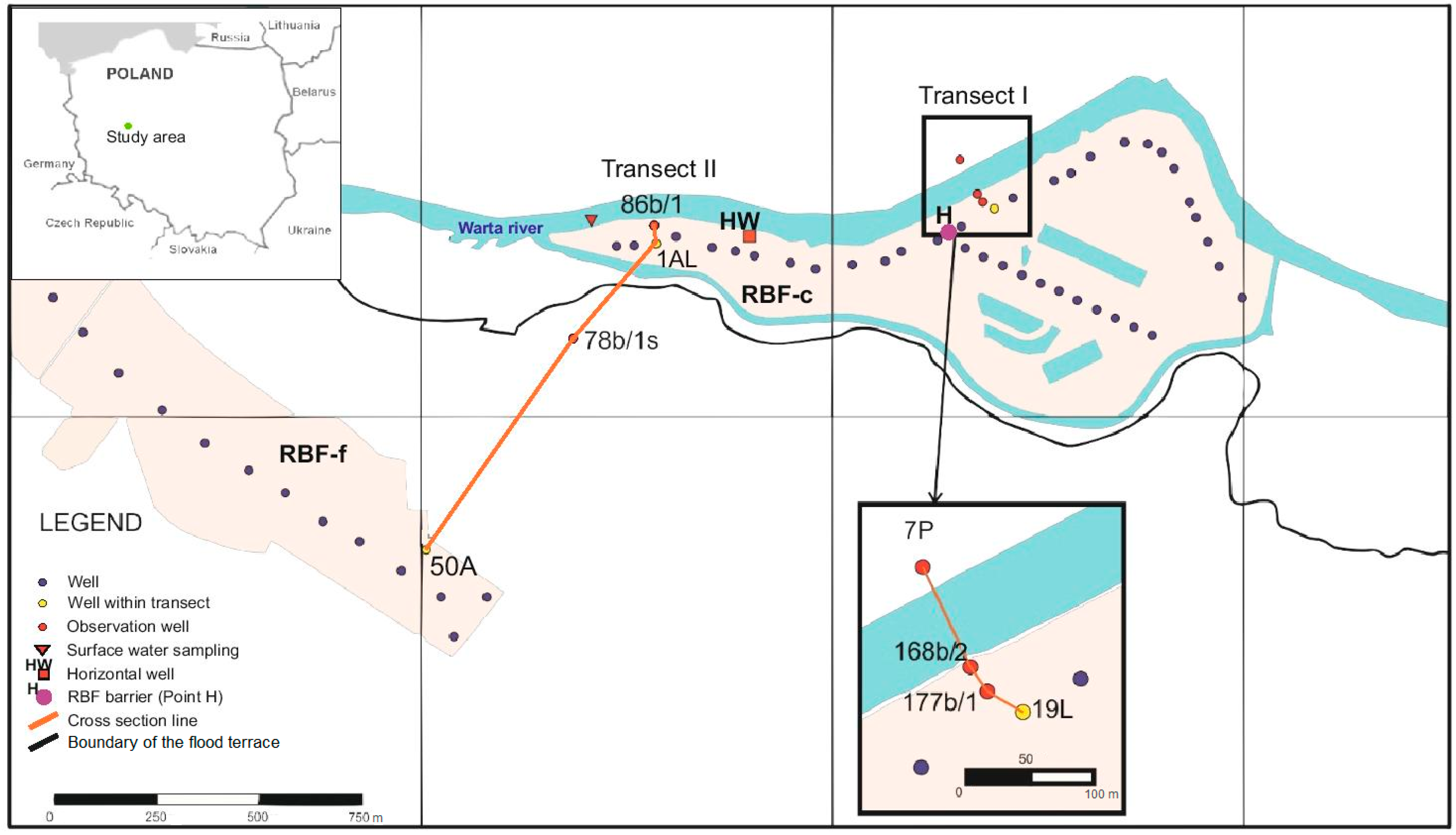
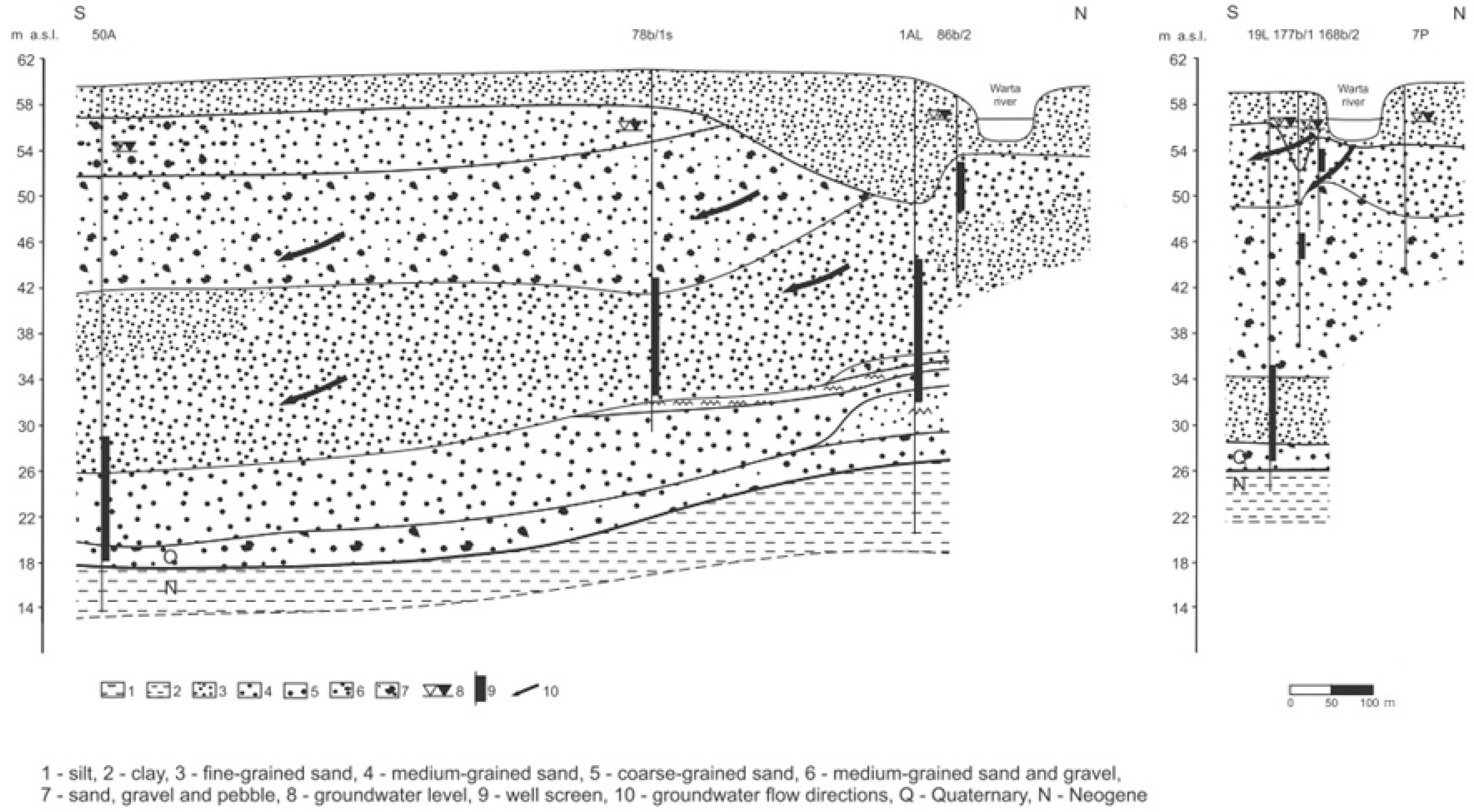
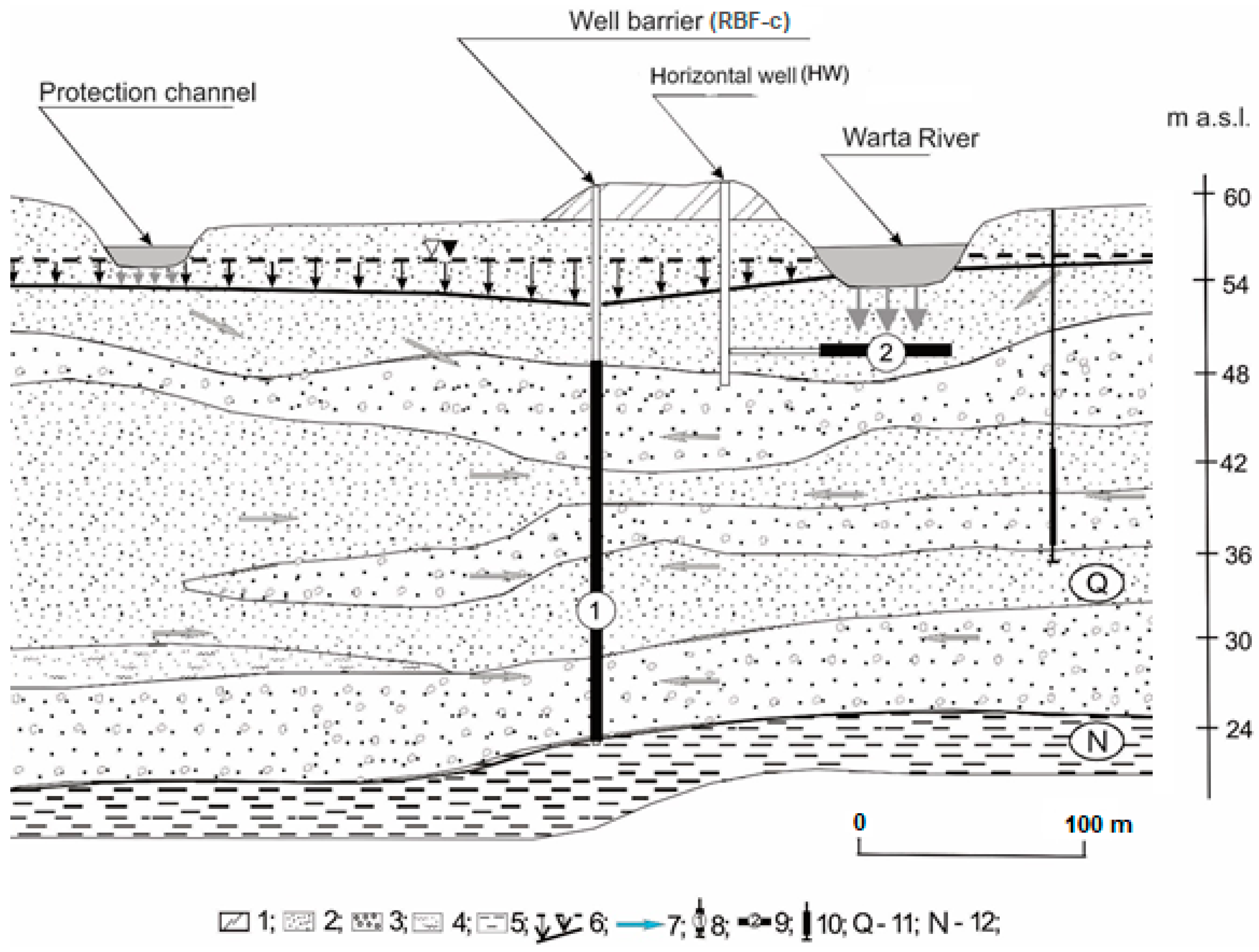
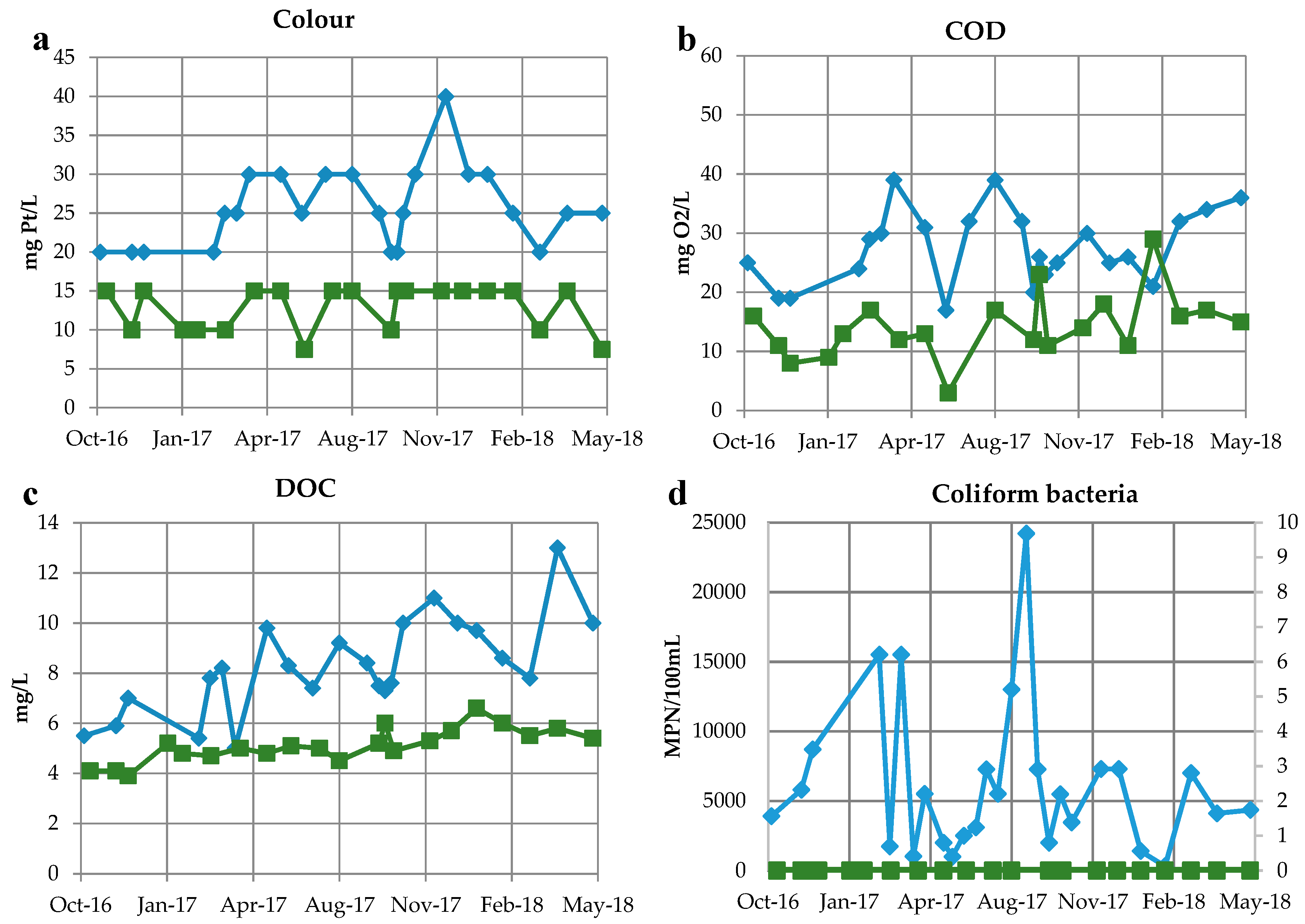
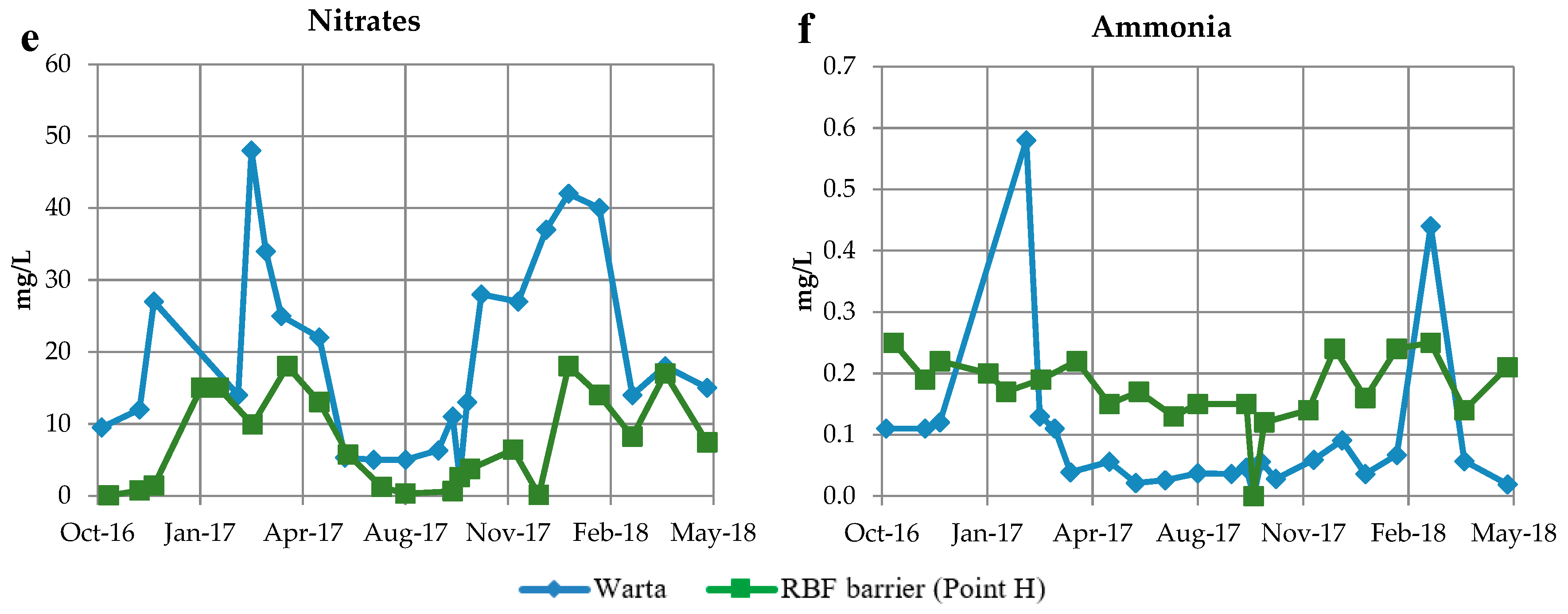
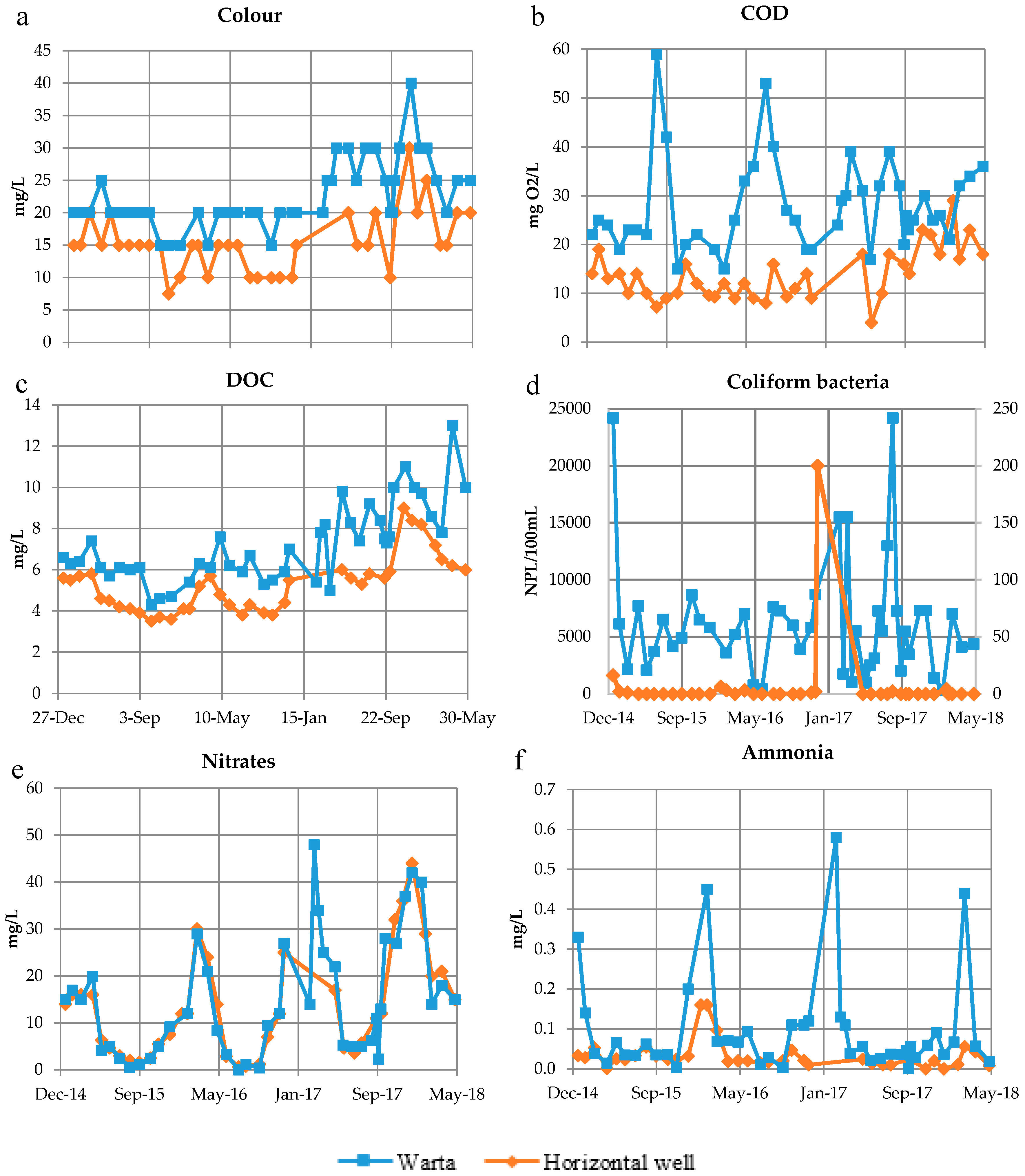
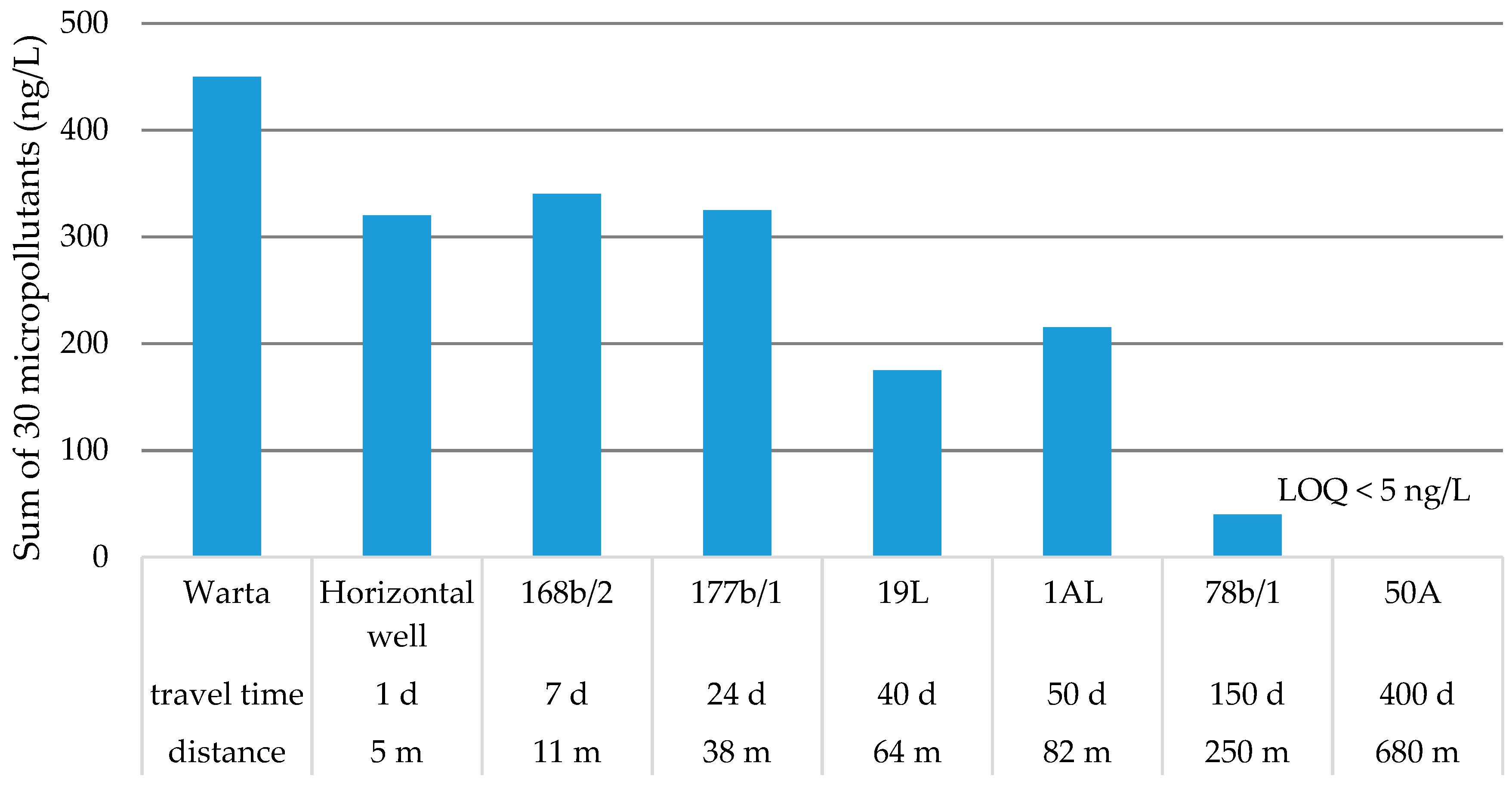
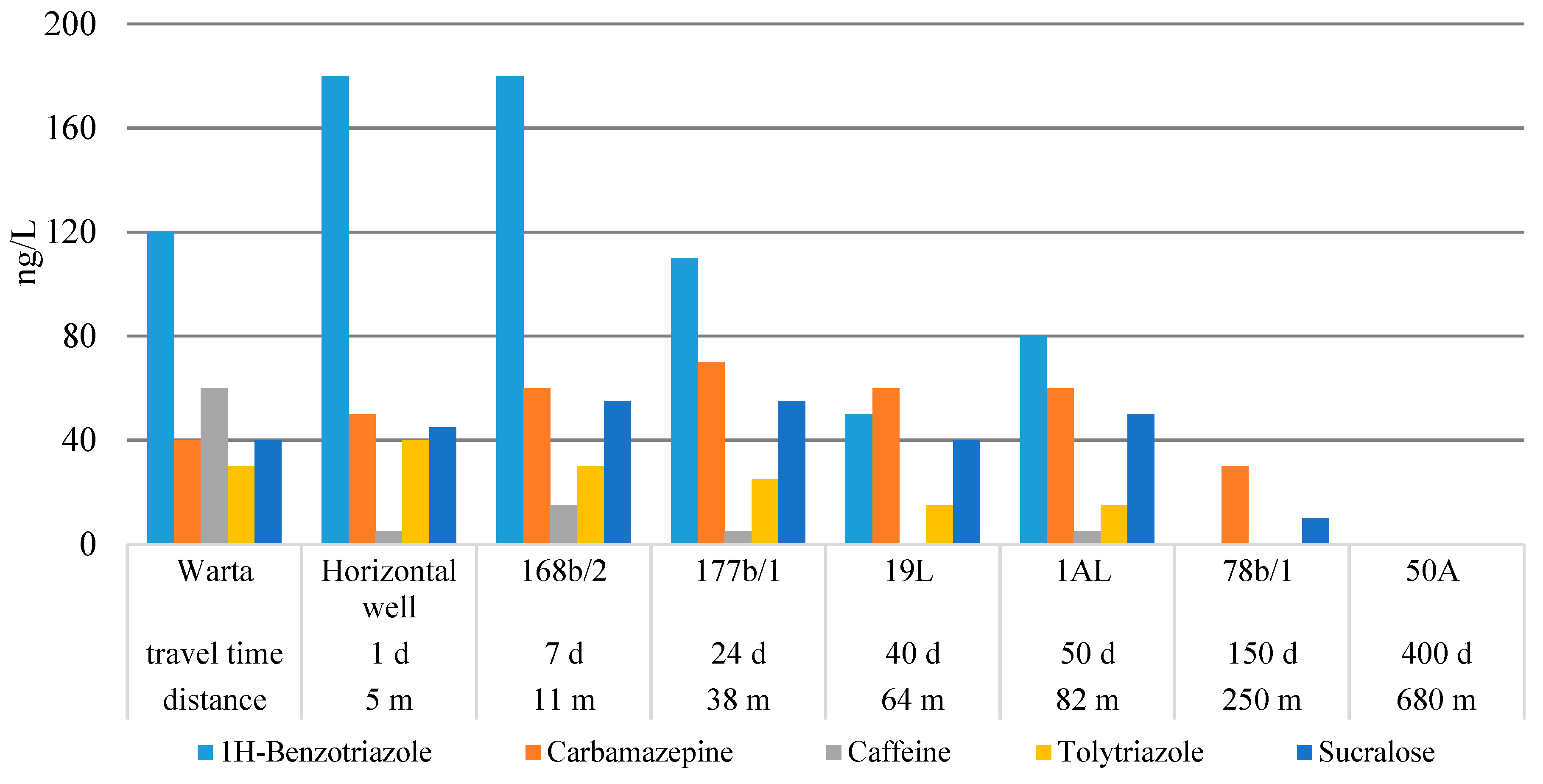
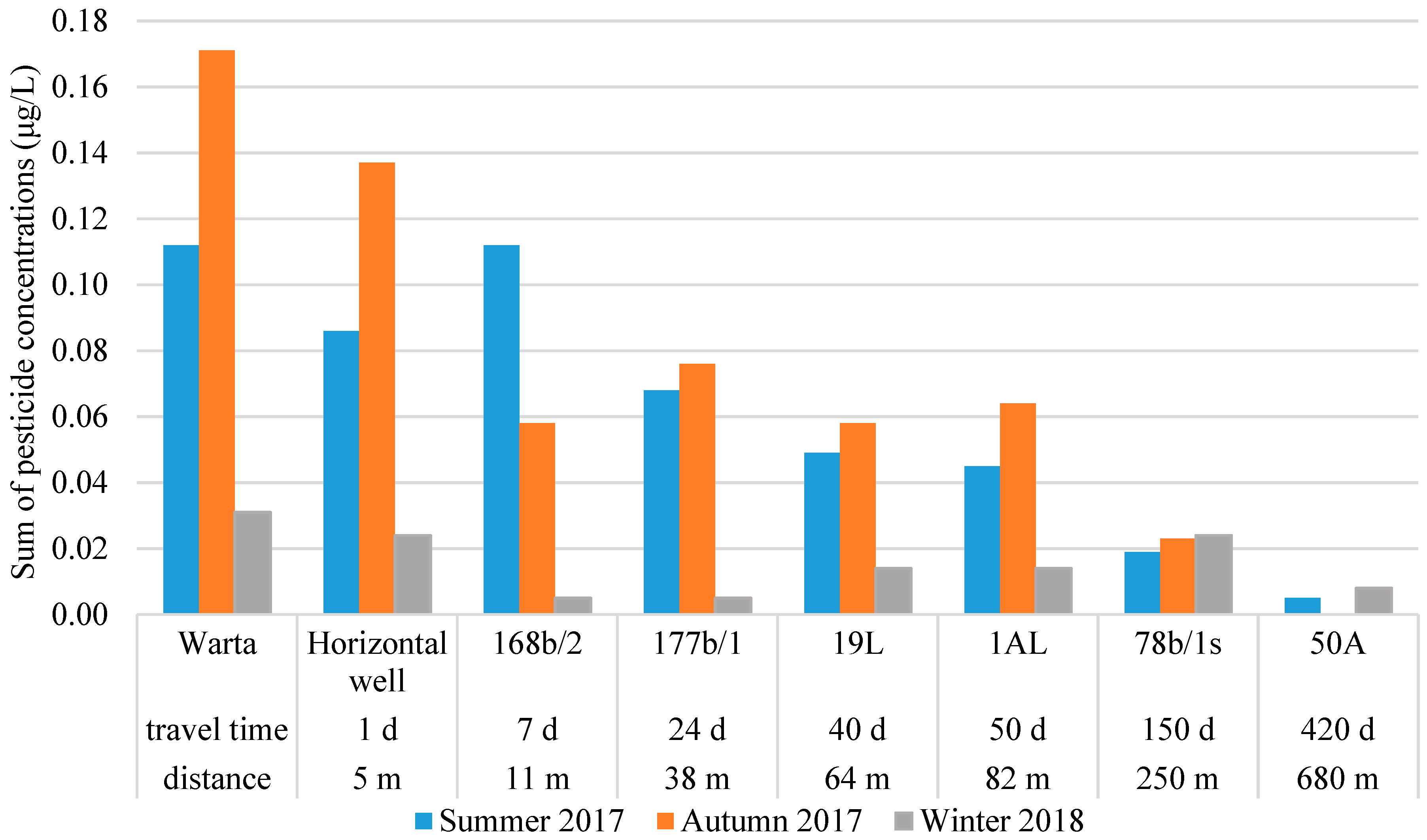
| Parameters | Colour (mg Pt/L) | EC (μS/cm) | NO3 (mg/L) | NO2 (mg/L) | NH4 (mg/L) | COD (mg O2/L) | DOC (mg/L) | Coliform Bacteria MPN/100 mL |
|---|---|---|---|---|---|---|---|---|
| Warta river (n = 37) | ||||||||
| Average | 25 | 624 | 18.6 | 0.09 | 0.10 | 28.2 | 8.4 | 6154 |
| Median | 25 | 619 | 14.0 | 0.09 | 0.06 | 28.0 | 8.0 | 5475 |
| Minimum | 20 | 542 | 0.5 | 0.03 | 0.02 | 17.0 | 5.0 | 308 |
| Maximum | 40 | 703 | 48.0 | 0.18 | 0.58 | 44.0 | 13.0 | 24,200 |
| Standard deviation | 4 | 49 | 13.0 | 0.04 | 0.13 | 6.6 | 1.8 | 5432 |
| Horizontal well (HW) (n = 32) | ||||||||
| Average | 17 | 626 | 18.4 | 0.02 | 0.02 | 16.5 | 6.2 | 1 |
| Median | 17 | 614 | 16.0 | 0.01 | 0.02 | 17.5 | 5.9 | 1 |
| Minimum | 10 | 539 | 3.6 | 0.00 | 0.00 | 4.0 | 3.8 | 0 |
| Maximum | 30 | 695 | 44.0 | 0.11 | 0.06 | 29.0 | 9.0 | 2 |
| Standard deviation | 5 | 56 | 12.0 | 0.03 | 0.02 | 6.2 | 1.5 | 1 |
| Reduction/Increase (average) | 32.5% | −0.4% | 0.9% | 74.8% | 80.5% | 41.5% | 26.01% | 99.98% |
| RBF barrier (Point H) (n = 21) | ||||||||
| Average | 13 | 650 | 7.8 | 0.09 | 0.19 | 13.8 | 5.0 | 0 |
| Median | 15 | 662 | 6.4 | 0.11 | 0.18 | 13.0 | 5.0 | 0 |
| Minimum | 7.5 | 581 | 0.0 | 0.02 | 0.12 | 3.0 | 3.9 | 0 |
| Maximum | 15 | 695 | 18.0 | 0.16 | 0.25 | 29.0 | 6.6 | 0 |
| Standard deviation | 2 | 33 | 6.8 | 0.04 | 0.04 | 5.2 | 0.7 | 0 |
| Reduction/Increase (average) | 49.8% | −4.3% | 58.1% | −6.9% | −91.5% | 51.1% | 40.3% | 100% |
| Well 19L (n = 10) | ||||||||
| Average | 15 | 614 | 0.58 | 0.03 | 0.19 | 9.8 | 5.0 | 0 |
| Median | 15 | 622 | 0.23 | 0.02 | 0.21 | 9.0 | 5.1 | 0 |
| Minimum | 10 | 580 | 0.00 | 0.01 | 0.10 | 3.0 | 4.3 | 0 |
| Maximum | 20 | 652 | 1.91 | 0.09 | 0.27 | 20.0 | 5.8 | 0 |
| Standard deviation | 4 | 29 | 0.68 | 0.03 | 0.07 | 6.83 | 0.6 | 0 |
| Reduction/Increase (average) | 42.1% | 1.5% | 96.9% | 64.2% | −99.9% | 65.3% | 40.4% | 100% |
| Well 1AL (n = 12) | ||||||||
| Average | 13.75 | 598 | 1.55 | 0.04 | 0.61 | 8.6 | 4.9 | 0 |
| Median | 10 | 612 | 1.23 | 0.03 | 0.42 | 8.5 | 4.9 | 0 |
| Minimum | 10 | 563 | 0.91 | 0.01 | 0.14 | 3.7 | 4.1 | 0 |
| Maximum | 25 | 618 | 2.83 | 0.12 | 1.18 | 15.0 | 5.4 | 0 |
| Standard deviation | 5 | 24 | 0.80 | 0.04 | 0.45 | 4.7 | 0.6 | 0 |
| Reduction/Increase (average) | 46.9% | 4.1% | 91.7% | 54.0% | -529% | 69.6% | 42.4% | 100% |
| Sampling Point | 1H-Benzotriazole | Carbamazepine | Caffeine | Sulfamethoxazole | Tolytriazole | Chlorothiazide | Ibuprofen | Sucralose | Sum |
|---|---|---|---|---|---|---|---|---|---|
| Warta River | 120 | 40 | 60 | 15 | 30 | <LOQ | 20 | 40 | 450 |
| Horizontal well | 180 | 50 | 5 | <LOQ | 40 | <LOQ | <LOQ | 45 | 320 |
| 168b/2 | 180 | 60 | 15 | <LOQ | 30 | <LOQ | <LOQ | 55 | 340 |
| 177b/1 | 110 | 70 | 5 | 15 | 25 | 5 | 40 | 55 | 325 |
| 19L | 50 | 60 | <LOQ | <LOQ | 15 | 10 | <LOQ | 40 | 175 |
| 1AL | 80 | 60 | 5 | <LOQ | 15 | 5 | <LOQ | 50 | 215 |
| 78b/1s | <LOQ | 30 | <LOQ | <LOQ | <LOQ | <LOQ | <LOQ | 10 | 40 |
| 50A | <LOQ | <LOQ | <LOQ | <LOQ | <LOQ | <LOQ | <LOQ | <LOQ | <LOQ |
| Sampling Period | Sampling Point | Imidacloprid | Isoproturon | M-Metalaxyl | Metazachlor | Nicosulfuron | Terbuthylazine | Chlortoluron | S-Metolachlor | Prometryn | Terbutryn | Sum |
|---|---|---|---|---|---|---|---|---|---|---|---|---|
| August 2017 | Warta | 0.007 | 0.008 | 0.005 | 0.036 | 0.012 | 0.008 | <LOQ | <LOQ | <LOQ | <LOQ | 0.112 |
| Horizontal well | 0.005 | <LOQ | 0.007 | 0.015 | 0.021 | 0.008 | <LOQ | <LOQ | <LOQ | <LOQ | 0.086 | |
| 168b/2 | 0.009 | 0.006 | 0.015 | <LOQ | 0.03 | 0.012 | 0.012 | 0.006 | 0.006 | <LOQ | 0.112 | |
| 177b/1 | 0.011 | <LOQ | 0.006 | <LOQ | 0.012 | 0.008 | 0.017 | 0.006 | 0.008 | <LOQ | 0.068 | |
| 19L | 0.007 | <LOQ | <LOQ | <LOQ | 0.017 | <LOQ | 0.018 | <LOQ | 0.007 | <LOQ | 0.049 | |
| 1AL | 0.005 | <LOQ | <LOQ | <LOQ | 0.016 | <LOQ | 0.016 | <LOQ | 0.008 | <LOQ | 0.045 | |
| 78b/1s | <LOQ | 0.012 | <LOQ | <LOQ | <LOQ | <LOQ | 0.007 | <LOQ | <LOQ | <LOQ | 0.019 | |
| 50A | <LOQ | <LOQ | <LOQ | <LOQ | <LOQ | <LOQ | <LOQ | <LOQ | <LOQ | <LOQ | ||
| November 2017 | Warta | <LOQ | 0.009 | 0.005 | 0.03 | 0.023 | 0.006 | 0.047 | 0.009 | <LOQ | 0.007 | 0.171 |
| Horizontal well | 0.007 | 0.007 | 0.005 | 0.021 | 0.019 | 0.007 | 0.032 | 0.008 | <LOQ | 0.007 | 0.137 | |
| 168b/2 | 0.008 | <LOQ | <LOQ | 0.007 | 0.018 | <LOQ | 0.005 | 0.005 | <LOQ | 0.006 | 0.058 | |
| 177b/1 | 0.007 | <LOQ | <LOQ | 0.007 | 0.017 | 0.007 | 0.008 | 0.006 | 0.006 | 0.008 | 0.076 | |
| 19L | 0.007 | <LOQ | <LOQ | <LOQ | 0.024 | <LOQ | 0.01 | 0.005 | 0.006 | 0.006 | 0.058 | |
| 1AL | 0.007 | 0.006 | <LOQ | <LOQ | 0.02 | <LOQ | 0.012 | 0.006 | 0.007 | 0.006 | 0.064 | |
| 78b/1s | <LOQ | 0.014 | <LOQ | <LOQ | <LOQ | <LOQ | 0.009 | <LOQ | <LOQ | <LOQ | 0.023 | |
| 50A | <LOQ | <LOQ | <LOQ | <LOQ | <LOQ | <LOQ | <LOQ | <LOQ | <LOQ | <LOQ | ||
| February 2018 | Warta | 0.005 | 0.008 | <LOQ | <LOQ | <LOQ | <LOQ | 0.012 | <LOQ | 0.006 | <LOQ | 0.031 |
| Horizontal well | <LOQ | 0.006 | <LOQ | <LOQ | <LOQ | <LOQ | 0.013 | <LOQ | 0.005 | <LOQ | 0.024 | |
| 168b/2 | <LOQ | <LOQ | <LOQ | <LOQ | <LOQ | <LOQ | 0.005 | <LOQ | <LOQ | <LOQ | 0.005 | |
| 177b/1 | <LOQ | <LOQ | <LOQ | <LOQ | <LOQ | <LOQ | <LOQ | <LOQ | <LOQ | <LOQ | ||
| 19L | <LOQ | 0.005 | <LOQ | <LOQ | <LOQ | <LOQ | 0.009 | <LOQ | <LOQ | <LOQ | 0.014 | |
| 1AL | <LOQ | 0.005 | <LOQ | <LOQ | <LOQ | <LOQ | 0.009 | <LOQ | <LOQ | <LOQ | 0.014 | |
| 78b/1s | <LOQ | 0.015 | <LOQ | <LOQ | <LOQ | <LOQ | 0.009 | <LOQ | <LOQ | <LOQ | 0.024 | |
| 50A | <LOQ | 0.008 | <LOQ | <LOQ | <LOQ | <LOQ | <LOQ | <LOQ | <LOQ | <LOQ | 0.008 |
© 2018 by the authors. Licensee MDPI, Basel, Switzerland. This article is an open access article distributed under the terms and conditions of the Creative Commons Attribution (CC BY) license (http://creativecommons.org/licenses/by/4.0/).
Share and Cite
Dragon, K.; Górski, J.; Kruć, R.; Drożdżyński, D.; Grischek, T. Removal of Natural Organic Matter and Organic Micropollutants during Riverbank Filtration in Krajkowo, Poland. Water 2018, 10, 1457. https://doi.org/10.3390/w10101457
Dragon K, Górski J, Kruć R, Drożdżyński D, Grischek T. Removal of Natural Organic Matter and Organic Micropollutants during Riverbank Filtration in Krajkowo, Poland. Water. 2018; 10(10):1457. https://doi.org/10.3390/w10101457
Chicago/Turabian StyleDragon, Krzysztof, Józef Górski, Roksana Kruć, Dariusz Drożdżyński, and Thomas Grischek. 2018. "Removal of Natural Organic Matter and Organic Micropollutants during Riverbank Filtration in Krajkowo, Poland" Water 10, no. 10: 1457. https://doi.org/10.3390/w10101457





